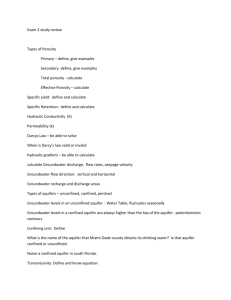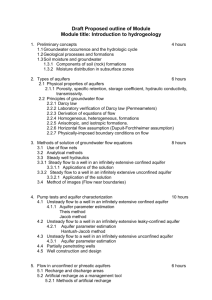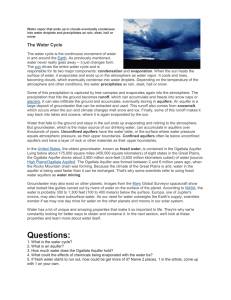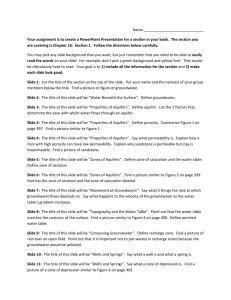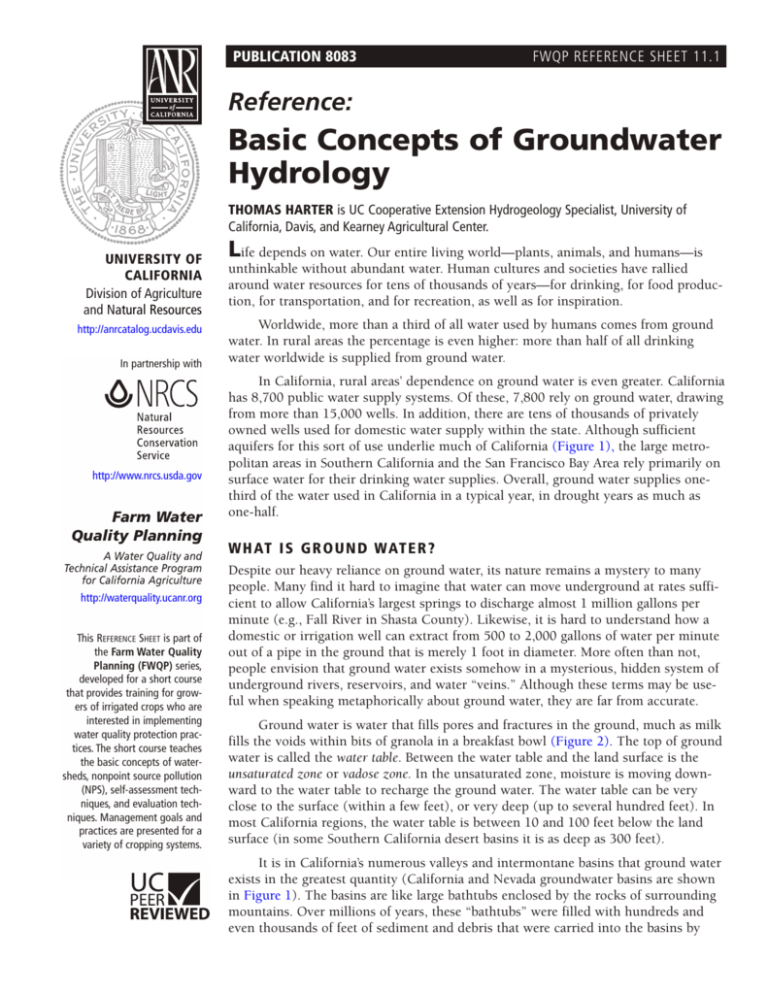
PUBLICATION 8083
FWQP REFERENCE SHEET 11.1
Reference:
Basic Concepts of Groundwater
Hydrology
THOMAS HARTER is UC Cooperative Extension Hydrogeology Specialist, University of
California, Davis, and Kearney Agricultural Center.
UNIVERSITY OF
CALIFORNIA
Division of Agriculture
and Natural Resources
http://anrcatalog.ucdavis.edu
In partnership with
http://www.nrcs.usda.gov
Farm Water
Quality Planning
A Water Quality and
Technical Assistance Program
for California Agriculture
http://waterquality.ucanr.org
This REFERENCE SHEET is part of
the Farm Water Quality
Planning (FWQP) series,
developed for a short course
that provides training for growers of irrigated crops who are
interested in implementing
water quality protection practices. The short course teaches
the basic concepts of watersheds, nonpoint source pollution
(NPS), self-assessment techniques, and evaluation techniques. Management goals and
practices are presented for a
variety of cropping systems.
L
ife depends on water. Our entire living world—plants, animals, and humans—is
unthinkable without abundant water. Human cultures and societies have rallied
around water resources for tens of thousands of years—for drinking, for food production, for transportation, and for recreation, as well as for inspiration.
Worldwide, more than a third of all water used by humans comes from ground
water. In rural areas the percentage is even higher: more than half of all drinking
water worldwide is supplied from ground water.
In California, rural areas’ dependence on ground water is even greater. California
has 8,700 public water supply systems. Of these, 7,800 rely on ground water, drawing
from more than 15,000 wells. In addition, there are tens of thousands of privately
owned wells used for domestic water supply within the state. Although sufficient
aquifers for this sort of use underlie much of California (Figure 1), the large metropolitan areas in Southern California and the San Francisco Bay Area rely primarily on
surface water for their drinking water supplies. Overall, ground water supplies onethird of the water used in California in a typical year, in drought years as much as
one-half.
W H AT I S G R O U N D WAT E R ?
Despite our heavy reliance on ground water, its nature remains a mystery to many
people. Many find it hard to imagine that water can move underground at rates sufficient to allow California’s largest springs to discharge almost 1 million gallons per
minute (e.g., Fall River in Shasta County). Likewise, it is hard to understand how a
domestic or irrigation well can extract from 500 to 2,000 gallons of water per minute
out of a pipe in the ground that is merely 1 foot in diameter. More often than not,
people envision that ground water exists somehow in a mysterious, hidden system of
underground rivers, reservoirs, and water “veins.” Although these terms may be useful when speaking metaphorically about ground water, they are far from accurate.
Ground water is water that fills pores and fractures in the ground, much as milk
fills the voids within bits of granola in a breakfast bowl (Figure 2). The top of ground
water is called the water table. Between the water table and the land surface is the
unsaturated zone or vadose zone. In the unsaturated zone, moisture is moving downward to the water table to recharge the ground water. The water table can be very
close to the surface (within a few feet), or very deep (up to several hundred feet). In
most California regions, the water table is between 10 and 100 feet below the land
surface (in some Southern California desert basins it is as deep as 300 feet).
It is in California’s numerous valleys and intermontane basins that ground water
exists in the greatest quantity (California and Nevada groundwater basins are shown
in Figure 1). The basins are like large bathtubs enclosed by the rocks of surrounding
mountains. Over millions of years, these “bathtubs” were filled with hundreds and
even thousands of feet of sediment and debris that were carried into the basins by
2
ANR Publication 8083
rivers and floods (Figure 3). In these socalled alluvial basins, ground water fills
small, often microscopic pores between the
grains of gravel, sand, silt, and clay.
In the rocks that make up the hills and
mountains of California’s uplands, ground
water is also quite common, although in
most cases not nearly as plentiful. In these
rocks ground water occupies practically
every fracture and fissure below the water
table. However, unless fractures are large
and numerous, little water can be extracted.
AQ U I F E R S, AQ U I TA R D S, A N D
SPRINGS
Explanation
Basin and Range aquifers
Basin fill aquifers
Carbonate-rock aquifers
Volcanic rock aquifers
Central Valley aquifer system
Coastal Basins aquifers
Miocene basaltic-rock aquifers
Northern California basin-fill aquifers
Northern California volcanic-rock aquifers
Not a principal aquifer
0
Volcanic- and sedimentary-rock aquifers
0
25
25
50
50
75
75
100 miles
100 KILOMETERS
Base modified from U.S. Geological Survey digital data,
1:2,000,000, 1972 Albers Equal-Area Conic projection
Standard parallels 29°30’ and 45°30’, central meridian -96°00’
Figure 1. Groundwater basins of California and Nevada
(Source: http://capp.water.usgs.gov/gwa/ch_b/index.html,
USGS Groundwater Atlas Figure 11 in section HA 730-B).
consolidated sediment
porous sediment
A geologic formation from which significant
amounts of ground water can be pumped
for domestic, municipal, or agricultural uses
is known as an aquifer. In some cases,
aquifers are vertically separated from each
other by geologic formations that permit little or no water to flow in or out. A formation that acts as such a water barrier is
called aquitard if it is much less permeable
than a nearby aquifer but still permits flow
(e.g., sandy clay). If the water barrier is
almost impermeable (e.g., clay) and forms a
formidable flow barrier between aquifers, it
is known as an aquiclude.
Aquifers can be of two major types:
unconfined or confined. An unconfined
aquifer has no overlying aquitard or
aquiclude (Figure 4). Where there are multiple levels of aquifers, the uppermost
aquifer typically is unconfined. Vertical recharge of an unconfined aquifer by rainwater or irrigation water that filters downward through the soil is not restricted. The
water table at the top of the unconfined
aquifer can migrate freely up and down within the sediment formation, depending on
how much water is stored there (Figure 3).
The water level in a borehole drilled into an
unconfined aquifer will be at the same depth
as the water table in the aquifer.
dissolution of rock
rock fractures
Figure 2. Types of pore space in sediments and rocks.
poorly sorted sediment
well-sorted sediment
A confined aquifer, on the other hand,
is sandwiched between an aquitard above and
an aquiclude or aquitard (e.g., bedrock)
below (Figure 4). Because the water table in
the recharge area of the confined aquifer is
much higher than the top of the confined
aquifer itself, water in a confined aquifer is
pressurized. This pressurization means that
3
ANR Publication 8083
the water level in a borehole drilled into a
confined aquifer will rise significantly above
the top of the aquifer. A flowing artesian well
occurs where the pressure is so high that the
water level in a well drilled into the confined aquifer rises above the land surface—
in other words, an open well flows freely
with no pumping.
Vadose zone
▼
Recharge
Bedrock
Aquifer
Sometimes hydrogeologists use the
term semi-confined aquifer if an aquifer acts
partly like a confined aquifer (particularly if
pumping rates are low or if pumping is necessary only over a relatively short period of
time) and partly like an unconfined aquifer
(for example, after long periods of heavy
pumping).
Springs form where the water table
intersects with the land surface: for example, in a small depression (common on hillsides). Sometimes ground water is forced
into a spring because a low permeable layer of rock or fine sediments (clay) keeps the
water from percolating deeper. A spring may also occur where subsurface pressure
forces water to the surface through a fracture or fault zone that acts as a conduit for
water movement from a confined aquifer.
Figure 3. Schematic cross-section of an unconfined aquifer in a California valley
filled with alluvial sediments. The bottom point of the inverted triangle indicates the
position of the water table.
D I R E C T I O N A N D S P E E D O F G R O U N D WAT E R M OV E M E N T
Bedrock
Unconfined
aquifer
Semi-confined
aquifer zone
Ground water moves from higher elevations to lower elevations and from locations of
higher pressure to locations of lower pressure. Typically, this movement is quite slow,
on the order of less than one foot per day to a few tens of feet per day. In groundwater
hydraulics (the science of groundwater movement), water pressure surface and water
table elevation are referred to as the hydraulic head. Hydraulic head is the driving
force behind groundwater movement.
Groundwater movement is always in the
downward direction of the hydraulic
head gradient (Figure 5). If there is no
hydraulic head gradient, there is no
flow. The hydraulic gradient is often but
not always similar to that of the land
surface. In most areas of California’s valleys and basins the hydraulic gradient is
in the range of 0.5 to 10 feet per thousand feet (0.05 to 1.0 percent).
Aquitard
Confined
aquifer
Figure 4. Unconfined, semi-confined, and confined aquifers in a typical California
alluvial basin. Dark-colored sediments indicate fine-grained clay or predominantly
clay materials (aquitard). Light-colored materials indicate coarser-grained aquifer
materials.
Groundwater movement in gravels
and sands is relatively rapid, whereas it
is exceedingly slow in clay or in tiny
rock fractures. The ability of geologic
material to move ground water is called
hydraulic conductivity. It is measured in
gallons per day per square foot (gpd/ft2)
or in feet per day (ft/day). The amount
4
ANR Publication 8083
lo
41
0
Ra
ng
46
e
e
Hi
46
County
l ls
40
250
ng
e
Lu
cia
350
375
ai
n
450
500 58
La
275
za
n
Pa
Santa
Margarita
e
ng
Salinas
Reservoir
Ra
300
101
Pl
101
400 25
4
58
zo
250
250
rri
Atascadero
Ca
e
ng
Ra
Scale:
Kilometres
0 2 4 6 8 10 12
0 2 4 6 8
Ra
a
Creston
225
41
Note:
Water levels in
metres above mean
41
300
325
Templeton
Legend:
Nonwater bearing
or
nt
46
bl
200
225 0 5
25 27
m
Te
Shandon
Paso Robles
Kern
5
275
250
225
17
101
G14
200
am
175
35
ol
225
250
45
32 400 0
30 5 350
0
ab
175
San Miguel
Ch
San Luis Obispo
Di
County
County
Monterey
Sa
Metres Feet
500 = 1640
350 = 1476
425 = 1394
400 = 1312
350 = 1148
325 = 1065
300 = 984
275 = 902
250 = 820
225 = 738
200 = 556
175 = 574
Figure 5. Water level contours and approximate direction of groundwater flow (arrows) in the Paso Robles
Basin, Monterey and San Luis Obispo Counties, California. Source: California Department of Water
Resources.
of groundwater flow is greater with higher hydraulic conductivity, even if the
hydraulic gradient is the same. The hydraulic conductivity of sandy or gravelly
aquifers typically ranges from 100 to 10,000 gallons per day (gpd) per square foot
(approximate equivalent: 10 to 1,000 ft/day). On the other hand, the hydraulic conductivity of clays, which consist of tiny particles that stick together and block water
movement, is a tiny fraction of the hydraulic conductivity of a sandy aquifer: 0.001
gallon per day per square foot or less. The hydraulic conductivity of fractured rock
depends greatly on the degree of fracturing. It may be as high as 10 to 100 gpd per
square foot (approximately 1 to 10 ft/day).
The groundwater velocity is the product of hydraulic conductivity and hydraulic
gradient, with adjustments for the porosity of the soil material (usually from 5 to 20
percent):
groundwater velocity = hydraulic conductivity hydraulic gradient
porosity
This is called Darcy’s Law, named after the French engineer Henry Darcy who first discovered this natural law in the Nineteenth Century. Typical groundwater velocity in a
sandy or gravelly aquifer may range from 0.5 to 50 feet per day.
G R O U N D WAT E R I N T H E C A L I F O R N I A H Y D R O L O G I C C Y C L E
Ground water is part of the hydrologic cycle (see Reference Sheet 10.1, Watershed
Function [ANR Publication 8064]). Aquifers are recharged from precipitation, seepage from rivers, and seepage from irrigated fields. If no one pumps the ground water,
aquifers eventually “overflow;” that is, they discharge water to the surface through
springs and seepage along river beds and lakes in the lower parts of California’s valleys and basins. A century of groundwater pumping has lowered water levels in many
5
ANR Publication 8083
areas of California and established a new balance between recharge and groundwater
pumping. During a series of wet years less water is pumped from wells, and that
allows water levels to rise as a result of surplus recharge. During dry years, however,
the amount of recharge water is typically much less than the amount of ground water
pumped and groundwater levels drop. If groundwater recharge cannot keep pace with
extraction over an extended period of years, despite the absence of a major drought,
the groundwater basin is said to be in overdraft.
In California the regional pattern of groundwater recharge and pumping and its
interaction with rivers is dictated by topography and the availability of surface water
for groundwater recharge. Most of California has a semi-arid to arid climate. The
largest amount of surface water available for recharge is near the mountain fronts
where perennial, intermittent, or ephemeral streams draining California’s uplands
(e.g., Coast Range, Sierra Nevada, mountain ranges of the desert southeast) flow onto
the highly permeable, unconsolidated sediments that fill California’s valleys and
basins. Thus, most of California’s streams provide significant groundwater recharge.
Rainfall also recharges ground water, but in California’s large groundwater basins
direct recharge from precipitation accounts for only a minor fraction of the total
recharge. In the agricultural valleys, deep percolation from summer irrigation is a
much more important source of recharge than winter precipitation. Recharge from
natural precipitation is only significant in some of the coastal valleys, in inland basins
in northern California, and in the small groundwater basins nestled in California’s
mountain ranges.
F O R M O R E I N F O R M AT I O N
For more online information on groundwater-related topics,
visit http://waterquality.ucanr.org and http://groundwater.ucdavis.edu.
You’ll find detailed information on many aspects of field crop production and
resource conservation in these titles and in other publications, slide sets,
CD-ROMs, and videos from UC ANR:
California’s Groundwater Resources, publication 21393
Groundwater Quality and Groundwater Pollution, publication 8084
Watershed Function, publication 8064
To order these products, visit our online catalog at http://anrcatalog.ucdavis.edu.
You can also place orders by mail, phone, or FAX, or request a printed catalog of
publications, slide sets, CD-ROMs, and videos from
University of California
Agriculture and Natural Resources
Communication Services
6701 San Pablo Avenue, 2nd Floor
Oakland, California 94608-1239
Telephone: (800) 994-8849 or (510) 642-2431
FAX: (510) 643-5470
E-mail inquiries: danrcs@ucdavis.edu
An electronic version of this publication is available on the ANR Communication Services Web
site at http://anrcatalog.ucdavis.edu.
Publication 8083
© 2003 by the Regents of the University of California, Division of Agriculture and Natural
Resources. All rights reserved.
6
ANR Publication 8083
The University of California prohibits discrimination against or harassment of any person
employed by or seeking employment with the University on the basis of race, color, national origin, religion, sex, physical or mental disability, medical condition (cancer-related or genetic characteristics), ancestry, marital status, age, sexual orientation, citizenship, or status as a covered
veteran (special disabled veteran, Vietnam-era veteran or any other veteran who served on active
duty during a war or in a campaign or expedition for which a campaign badge has been authorized).
University Policy is intended to be consistent with the provisions of applicable State and Federal
laws.
Inquiries regarding the University’s nondiscrimination policies may be directed to the Affirmative
Action/Staff Personnel Services Director, University of California, Agriculture and Natural
Resources, 300 Lakeside Drive, 6th Floor, Oakland, CA 94612-3550 (510) 987-0096. For information about obtaining this publication, call (800) 994-8849. For information about downloading, call (530) 754-5112.
pr-7/03-WJC/CR
This publication has been anonymously peer reviewed for technical accuracy by University of California
scientists and other qualified professionals. This review process was managed by the ANR Associate
Editor for Natural Resources.



